Samsung SyncMaster 213T: The Glass Ceiling for Enthusiast LCD
by Kristopher Kubicki on February 20, 2004 4:24 AM EST- Posted in
- Displays
Full Screen Application
Here are a few quick looks at some demanding full screen applications (except solitaire, which is windowed). All of these screenshots are taken with DVI inputs on the LCDs. We used a Radeon 9800 XT for testing.
The Matrix Reload, The Matrix - We include these movies into our benchmark to test full motion video. As expected, the darks were much better on the 213T, but there was still a washed out blue tone. However, compared to our 2001FP, the 213T image looks like a screenshot. Both images were taken from the same position with the same lighting. Even though the two images are dramatically different, do not put all of your faith in them as digital cameras tend to over-exaggerate visual defects.
Magic the Gathering: Battlegrounds - We picked up a new game since our last benchmark, and in all honesty this is probably one of the better benchmarking games for an LCD; rich colors, fast motion, excessive contrast everywhere (the game is actually kind of fun to play, too). In any case, even though this is an expanded fantasy card game, MTG:B gives us a lot of opportunity to test motion blur due to its high level of activity. Motion blur was essentially non-existent; we did not experience any problems with the LCD keeping up with the rapid color changes on the screen.
Morrowind - Another solid 1600x1200 game we like to test LCD monitors on. Unfortunately, the sky in the game should not be as blue as it shows in this picture. This is partly due to the camera, but also due to the screen. On our 2001FP the sky is the (correct) grey, but the overall image has a more washed out look to it.
Max Payne 2 - Again one of our favorite games to benchmark LCDs because we get such different results each time we change LCDs. There is a slight blue hue to everything even though we have already calibrated our monitor with the OptiCal software. Even though there are some discrepancies in the color, the contrast levels are very good; unlike many other LCDs dark objects on dark backgrounds were difficult to distinguish. This is the desired effect in many games.
Halo - Halo gave our 2001FP a little bit of trouble. While we did notice motion blur, the camera over emphasized the issue due to the shutter rate. For avid gamers there is a noticeable difference between the 213T and the 2001FP, but it is difficult to distinguish. The 213T cannot keep up with the 2001FP; particularly with the constant light to dark imagery (rapid explosions in dark corridors).
Solitaire - For some reason, everyone enjoys our Solitaire benchmark. Indeed, with all that mind bending, card flipping excitement, its no wonder the most played PC game in history deserves its own benchmark.
Unlike our other images, do not confuse these image defects with the defects in the other pictures. The "two" mouse cursors are normal; we are catching two separate frames in the same image due to the cameras shutter rate. What is not normal is the blurring along the edges of the cursor. You can clearly see how the 2001FP has a crisper cursor; the SIPS panel is more capable for this type of imagery.


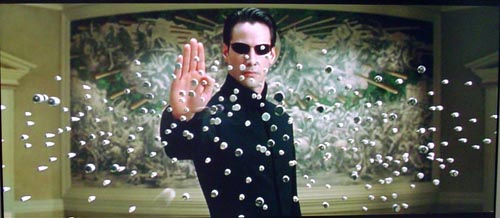

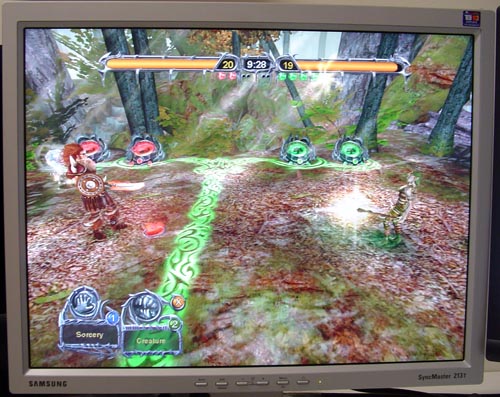
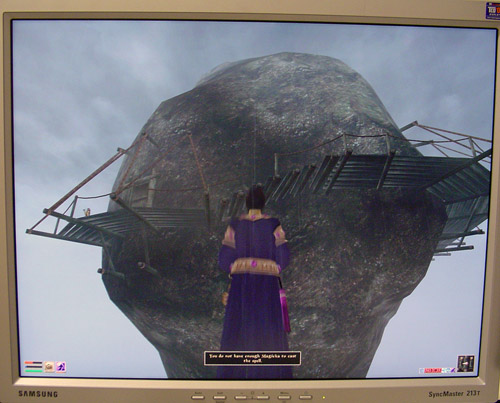
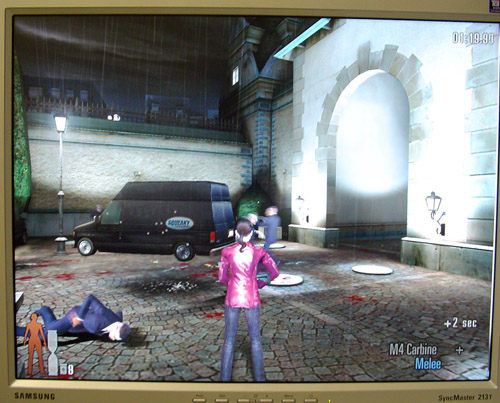
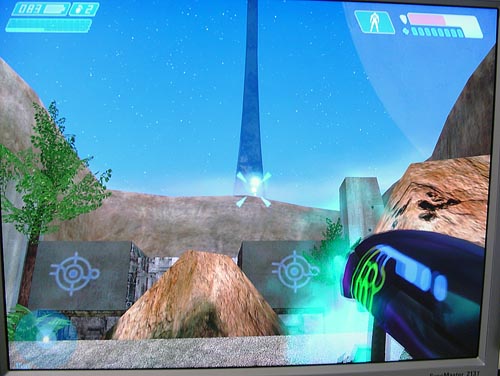










33 Comments
View All Comments
techna1 - Tuesday, September 14, 2004 - link
I just got 213T and I am semi-impressed with the display. After reading anandtech's review I was conviced that ghosting would be very minimal if not absent, but after playing COD, UT2004 and FarCry I have realized that is not so. I do not consider myself an avid gamer. I game a few times a month mainly at LAN parties butI found the ghosting to be very annoying especially in dark low contrast levels. COD is probably the worst due to the intense amount of dark grey, but UT2004 can also be bad too. In very dark areas you tend to lose a lot of information. For example dtails in dark corners in may UT2004 levels are completely lost on the Samsung compared to any standard CRT display. I tested the 213T and a high-end 21" CRT side by side using dual ouput and could really see the differences in dark or grey levels. I would suggest not purchasing this LCD is you plan to game more than a few hours per week. It's just not worth it. One saving point for games though is the intensity of the color and brightness. Explosions and light tend to be very intense and dramatic giving games an interesting edge that I have not seen on any CRT before. Basically from what I can tell, CRT produce much better black levels but LCD like the 213T win for producing brighter colors.However, for those who don't game I am pleased to report the LCD is excellent for other tasks such as text and graphics. The LCD is very sharp and bright making most standard windows tasks easy on the eyes. I was quickly annoyed when returing to a CRT for text just after a few hours on the 213T.
Lastly, DVD playback was pretty good, but I still had issues with DVDs that are very dark. After watching resident evil, I realized that LCDs just don't cut it where dark colors and lots of black is required. The black levels although good were still a little to bright to really make DVDs easy to watch (some reviewers claimed the black levels are equal to monitor when it is off, however that is entirely false). However, Shrek, a much brighter film, looked excellent and gave the 213T a chance to show off its vivid picture.
Bottom line: Not the best for gaming or DVDs, but everything else is the best I have seen on an LCD. I ended up keeping my CRT and running it in dual mode (extended desktop) on my 5950FX, using the 213T for everyday applications and my CRT for games and DVDs. Its a pretty good solution but I really wanted the LCD for LAN parties for easy transport but I guess I'll have to wait for something better for that.
BTW, I got my on ebay.com. You can easily pick one up for $800.00 + 35.00 shipping. The cheapest I found them retail were 980 before shipping, so ebay is by far the best bet.
Good luck!
davidjay - Tuesday, March 9, 2004 - link
An excellent, detailed review of the Samsung 213T LCD monitor, but I spotted one oversight:Your comment: "...the monitor must be tilted before rotated since there is not enough clearance between the panel and the stand...." indicates you're not aware that the stand has a vertical adjustment. Raise it a couple inches, and there's no need to tilt the panel back when rotating it 90 degrees and back.
KristopherKubicki - Wednesday, February 25, 2004 - link
dalhtech: Waiting for our sample.Kristopher
dalhtech - Wednesday, February 25, 2004 - link
Will Anand review the Sharp LL-T2015? From the specs it seems like a good balance between the Samsung and Dell's respective strengths.http://www.sharpsystems.com/products/lcd_monitors/...
DrumBum - Monday, February 23, 2004 - link
"We have some more monitors coming up later this month so stay tuned!"Which monitors are you reviewing?
Lorrin - Monday, February 23, 2004 - link
How does the color reproduction of a high-end monitor like this one compare to that of LCD's pitched at the graphic arts market -- like the Apple Cinema Display or the Formac monitors?Odeen - Monday, February 23, 2004 - link
[q]The pixel [0.27mm dot] pitch is a little too large for some tastes[/q]I don't know of a better way of putting this, but you DORKS!
Do the math.
sqrt(1600^2 + 1200^2) = sqrt(4000000) = 2000
So the monitor has two thousand pixels across the diagonal.
The monitor is 21.3" measured diagonally, which is 21.3*25.4 (mm/inches) = 541.02mm diagonally. Over half a meter! :)
541.02 mm / 2000 pixels =0.27051mm per pixel, or 0.27mm dot pitch.
Which means that EVERY 21" monitor capable of a maximum resolution of 1600x1200 will have .27mm diagonal pixels!
The only way to achieve a finer dot pitch is to a) increase the resolution w/o increasing size as much, which shrinks the image, or b) decrease image size.
That's why a Dell 2001FP will have a smaller dot pitch (.255mm, if I recall)- it has to pack the same 2.1 million pixels into an 11% smaller area!
A .27mm dot pitch on a 14" clunker means the resolution is severely limited. But there's no practical way to decrease the dot pitch on a behemoth such as this one. Nor is there a reason to.
KristopherKubicki - Monday, February 23, 2004 - link
23: they represent which generation the monitor is. The letter denotes teh feature.T: means the high end LCDs (dual input)
X: means low response time
N: means thin bezel for multimonitor
S: means system builder LCDs usually with just one vga input.
The 213T breaks teh batter for some reason but oh well.
Kristopher
wizardsinc - Monday, February 23, 2004 - link
I believe the 213T has a 21.3 inch diagonal, so it's possible that the last digit represents 10ths of an inch diagonal.airchie - Monday, February 23, 2004 - link
Can anyone tell me what the model numbers on Samsung screens mean?ie,
Theres 191T, 192T, 193T, 172x etc
obviously the first two digits are the screen size.
What do the third digit and the letter denote?
The letter (I think) tells you if it has speakers built in or other features etc.
Anyone know for sure what they all mean?